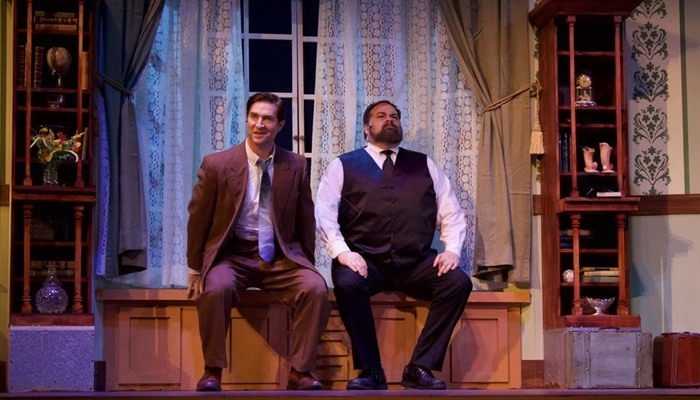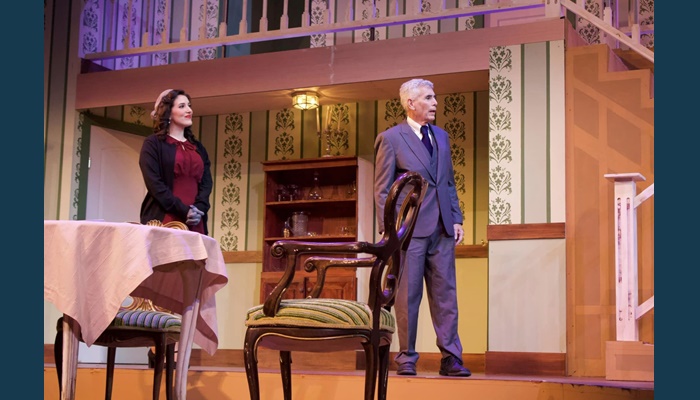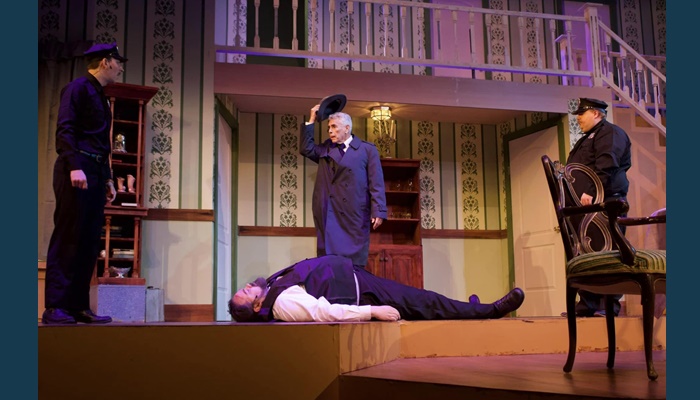SALT LAKE CITY, Utah, March 28, 2024 (Gephardt Daily) — So just a quick disclaimer; I have to admit right off the bat, one of the eras of theater I’m not super familiar with is the American stage in the first half of the 20th Century. Because I’m English, my theater education at university covered more of what was occuring in Britain at that time, and also in the U.S. from the late 1940s on, with the rise of mega-playwrights Tennessee Williams, Eugene O’Neill and Arthur Miller. So I came into the Grand Theatre’s production of the farcical black comedy “Arsenic and Old Lace,” by Joseph Kesselring, with a totally clean slate. I’d never read it, never seen the play or the film, and didn’t know the plot beyond a quick Google search.
The play, which opened in 1941, making it 83 years old, is currently running at the Grand Theatre at 1575 S. State St. in Salt Lake City as part of its American Classics series. The show opened on March 21 and goes through Saturday, April 6, with performances Thursday through Saturday at 7:30 p.m. and Saturday matinees at 2 p.m. Tickets and more information are available here.
Of the 12 plays written by Kesselring, “Arsenic and Old Lace” is by far the most successful. The show, which also spawned a 1944 film adaptation starring Cary Grant and directed by Frank Capra, opened on Broadway at the Fulton Theatre in 1941. According to the opening night review in The New York Times, the play was “so funny that none of us will ever forget it.” It then played for the majority of World War II, moving to the Hudson Theatre, and closing there in June 1944 after a whopping 1,444 performances. The West End production at the Strand Theatre opened in December 1942 and was also a smash hit, closing in March 1946, with a total of 1,337 performances.
It has been suggested that what inspired Joseph Kesselring to write the play was the real-life story of Amy Archer-Gilligan, a serial killer from Windsor, Connecticut who murdered between 20 and 100 people between 1907 and 1917. Archer-Gilligan lured seniors to her home under the pretense that she would care for them. A pattern of sudden deaths began to emerge and was soon recognized by families of some of Archer-Gilligan’s lodgers. Kesselring heard of the Archer-Gilligan story when he was a young boy, and as an adult, visited Connecticut and researched the case using the town’s records and newspaper archives. This, in turn, inspired him to write “Arsenic and Old Lace.”

The show, which is set in 1941 in Brooklyn, centers on the eccentric Brewster family. When Mortimer Brewster (played in the Grand Theatre production by Bryan Harper), a drama critic, visits from out of town, he discovers that his two spinster aunts, Abby and Martha Brewster (Betsy West and Alyssa Hickman Grove) have taken to murdering lonely old men by poisoning them with a glass of homemade elderberry wine, laced with arsenic, strychnine and “just a pinch of cyanide.” Mortimer’s brother Teddy (Jim Nelson) believes he is Theodore Roosevelt and digs locks for the Panama Canal in the cellar of the Brewster home (which then serve as graves for the aunts’ victims; he thinks that they died of yellow fever); and his other brother, Jonathan (David Hanson) is also a killer, with a body count that rivals his aunts. To conceal his identity, he has received plastic surgery performed by an alcoholic accomplice, Dr. Einstein (Isaac Maltby), a character based on real-life gangland surgeon Joseph Moran. Jonathan now looks like horror-film actor Boris Karloff (a self-referential joke, as the part was originally played on Broadway by Karloff).
I can absolutely see how “Arsenic and Old Lace” would be a smash hit during its original run. Bearing in mind that the play was written in 1939, right as the Second World War broke out, the theatrical trends in the U.S. at that time were for shows that provided escapism; mainly elaborate musicals, often with patriotic themes. It follows then, that comedy would also be popular, though dramatic theater suffered during the 1940s. American audiences were looking for some entertainment to take their minds off of the war in Europe and the growing fear that the U.S. would be pulled into it, while across the pond, theatergoers who were suffering through London post-blitz also needed some comic relief. My main reservation about the play presented in 2024 was that I did appreciate the comedy, but didn’t find it laugh out loud funny. Many of the period references went straight over my head; the show is full of topical jokes that were designed to play for the literary theater-goer in the 1940s, which fall a bit flat these days. I don’t know that much about Teddy Roosevelt, so I just didn’t get the punchlines about San Juan Hill, or his allusions to “digging the Panama Canal” when disposing of corpses, or the references to his presidential successors Taft and Wilson. Another example is Mortimer’s description of his family as: “If Strindberg wrote ‘Hellzapoppin;'” which is definitely amusing if you understand both of those references. I wondered if it might have been helpful to include notes in the program explaining some of the jokes.
I also felt, at a running time of nearly two-and-a-half hours, and three acts, with one 10-minute intermission, that some of the bits were repeated too often and therefore lost their sparkle a little. Numerous characters were saddled with one main joke that they had to find ways to make work numerous times, which got a bit tiresome. It’s also hard to maintain a taut pace when a show is that long.

The cast of 13, however, gave it their all and every single person delivered a brave, committed performance, directed with a sure hand by Anne Stewart Mark. Local theater legend West as Abby Brewster and Hickman Grove as her sister Martha both create characters who seem to be just as sweet as elderberry wine; they appear slightly baffled by their murderous shenanigans, which is amusing. Both actors are experts at physical comedy; another standout in that area is Harper as Mortimer Brewster, who scores many of the evening’s laughs. It’s Mortimer’s energy that carries the show along, and Harper did a fine job keeping that as high as possible. He’s well matched in his comedy chops by Katie Plott as his on-and-off fiance Elaine Harper. Standouts among the supporting cast include Hanson as Jonathan Brewster, and Robert A. Easton as Officer O’Hara, a frustrated cop who dreams of being a playwright and is dead set on telling Mortimer all about the script he’s been writing. Both are skilled actors; Hanson always has a commanding physical presence, and makes interesting and imaginative choices, while Easton milks his small role for every comedic moment.
If the Grand hasn’t quite scored with the script choice, the production values are, as always, a hit. The theater has a fantastic creative team, and their skills are nicely showcased here. The set, by resident designer Halee Rasmussen, is absolutely stunning, depicting a large, elegant living room (or was it called a parlor in those days?), with stairs that lead to an upper floor. Stewart Mark utilizes the set well to create comedic moments; there are a satisfying number of doors (five) that of course are used for physical comedy bits; because doors are so central to the humor in plays of this type, they are sometimes referred to as “door farces.” In this case, the play could also be called a “window farce;” the windows on the set are nicely used, particularly the one house left that various characters climb through. The costume design by resident Shannon McCullock is also a standout, with visually pleasing costumes that are perfectly appropriate for the period in which the play is set, while also making sure that the characters can move easily for the more physical parts of the show. Erin McCullock also does a terrific job with the wig and makeup design.
The lighting design by Spencer Brown and sound design by Joe Killian are both supporting characters in this show, but that’s perfectly appropriate given that it is all set in the Brewster living room. The lighting design consists primarily of a pleasant, warm wash that illuminates the space, but there’s various comedy bits involving the turning on and off of lights and all these worked well. The sound design is smooth, unobtrusive and just right for the period.

All in all, “Arsenic and Old Lace” was a satisfying night at the theater because of the commitment of the cast and director and the lovely production values. I wondered as I left whether modern audiences just have less patience than those in the past; there’s certainly a trend right now for short, punchy plays with no intermission. Given the state of the world in the first years of the 1940s, it follows that longer comedies like this would be a very welcome relief from day-to-day life and the hardships it presented. When it comes to more of a slow-burn show like this, maybe I just needed to turn my brain off, relax and let myself take it all in.
For tickets and more information about “Arsenic and Old Lace,” click here.
Coming next at the Grand is Jane Austen’s “Pride and Prejudice” adapted for the stage by local playwright Melissa Leilani Larson, from May 16 to June 8, on the main stage. Click here to read Gephardt Daily’s interview with Larson.









